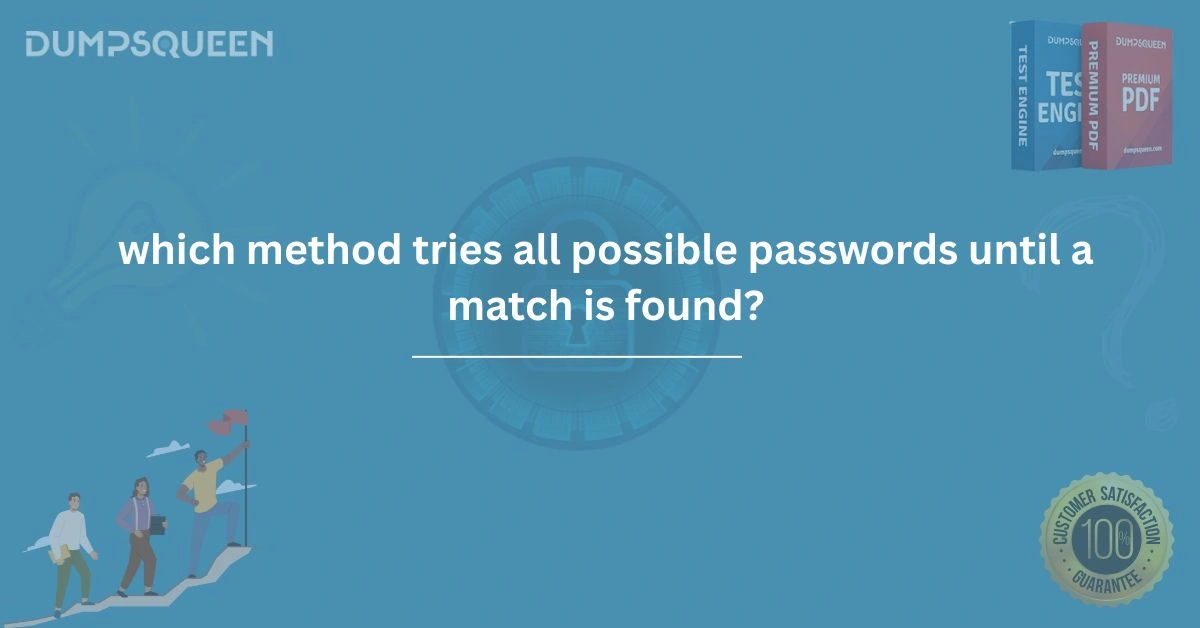Introduction
In today's digital world, security is a major concern. As technology advances, so do the methods used by cybercriminals to bypass security systems and gain unauthorized access. One such method is brute force attack, a technique where all possible passwords are tried until the correct one is found. This method is often used to crack encrypted data, unlock user accounts, or break into secure systems. Understanding how brute force attacks work, how they are implemented, and the implications for network security is crucial for both security professionals and those preparing for certifications in cybersecurity and IT fields. This blog will provide a deep dive into the concept of brute force attacks, the mechanics behind them, their effectiveness, and the measures that can be taken to protect against such attacks. We will also explore some sample questions and answers that are relevant to this topic, which may be useful for those preparing for their certification exams on platforms like DumpsQueen.
What is a Brute Force Attack?
A brute force attack is a method used by attackers to crack passwords or encryption by systematically trying all possible combinations until the correct one is found. This method is often seen as one of the most straightforward yet time-consuming techniques. Brute force attacks can target passwords, encryption keys, and other authentication methods that rely on a set of possible combinations. The power of brute force lies in its simplicity – by trying every possible combination, the attacker is guaranteed to find the right password eventually. However, the time it takes to do so increases exponentially as the length and complexity of the password or encryption key grows.
How Does a Brute Force Attack Work?
The mechanism behind a brute force attack is simple but effective. The attacker uses a program or script that generates all possible combinations of characters, numbers, and symbols, depending on the type of password being attacked. Each possible combination is then tested until the correct one is found. Brute force attacks can be performed using two main methods:
Dictionary Attack: This method uses a precompiled list of commonly used passwords or phrases (the "dictionary"). While it may not try all possible combinations, it’s faster because it focuses on more likely passwords.
Pure Brute Force Attack: This method tries all combinations from a predefined character set. If the password contains lower-case letters, numbers, and symbols, the attack will try every combination of these characters, starting from the shortest length and increasing it until it finds a match.
While brute force attacks are effective in theory, they are not always the most efficient. The time required to perform a brute force attack depends heavily on the password’s complexity. A simple 6-character password can be cracked in seconds, but a 20-character password with a mix of symbols, upper and lower case letters, and numbers could take years or even longer to break, depending on the system's speed and computing power.
The Risks of Brute Force Attacks
Brute force attacks are not without their risks and limitations, but they still pose a significant threat. The primary risk with this method is the sheer computational power required to try all combinations. For modern encryption standards, a brute force attack might be nearly impossible to execute successfully in a reasonable time frame. However, the increasing availability of powerful computing resources, cloud computing, and distributed computing networks have made brute force attacks much more feasible. Attackers can now use botnets or leverage the computational power of multiple machines to speed up the process, which makes them a serious threat to systems with weak password policies.
How to Protect Against Brute Force Attacks
There are several strategies to mitigate the risk of brute force attacks, including:
-
Use Strong Passwords: Strong, complex passwords are more difficult to crack through brute force. A combination of upper and lower case letters, numbers, and symbols increases the number of potential combinations and significantly lengthens the time it would take an attacker to guess the password.
-
Implement Account Lockouts: Many systems implement account lockout policies that temporarily lock a user out after a certain number of failed login attempts. This prevents an attacker from trying countless passwords in a short period of time.
-
Multi-Factor Authentication (MFA): By requiring an additional form of authentication (e.g., a code sent via SMS or an authenticator app), multi-factor authentication adds an extra layer of security, making it more difficult for attackers to gain unauthorized access.
-
Use CAPTCHA: CAPTCHA (Completely Automated Public Turing test to tell Computers and Humans Apart) can help block automated brute force attacks by requiring users to solve puzzles that a machine cannot easily decipher.
-
Salted Hashing: Storing passwords as salted hashes instead of plain text can prevent attackers from easily deciphering passwords even if they manage to access the database.
The Role of Brute Force Attacks in Cybersecurity
Brute force attacks highlight the importance of strong security practices. While brute force may seem like a "last resort" method for attackers, it is still one of the most widely used tools, particularly when other methods fail. Organizations must ensure their systems are equipped with protective measures like strong password policies, account lockouts, and multi-factor authentication to mitigate the risks posed by brute force attacks. Understanding brute force attacks is also crucial for individuals preparing for cybersecurity certifications. Whether you’re working toward a CompTIA Security+ or a Cisco Certified Network Associate (CCNA) exam, understanding the vulnerabilities and defense mechanisms against brute force attacks is essential.
Free Sample Questions
Question 1: Which method tries all possible passwords until a match is found?
A) Phishing Attack
B) Brute Force Attack
C) Social Engineering
D) Man-in-the-Middle Attack
Answer: B) Brute Force Attack
Question 2: What is the main disadvantage of a brute force attack?
A) It is very fast and efficient
B) It requires a high level of computational power and time
C) It cannot crack encrypted data
D) It is difficult to execute without special tools
Answer: B) It requires a high level of computational power and time
Question 3: How can multi-factor authentication help mitigate brute force attacks?
A) By allowing multiple login attempts
B) By requiring additional forms of verification beyond just the password
C) By increasing password length
D) By disguising the password
Answer: B) By requiring additional forms of verification beyond just the password
Conclusion
Brute force attacks represent a significant cybersecurity threat, but understanding how they work and how to defend against them can make all the difference in protecting your systems and data. By implementing strong password policies, account lockout measures, multi-factor authentication, and other security techniques, you can significantly reduce the risk posed by brute force methods. As we continue to rely on digital systems for personal and business purposes, it’s more important than ever to stay ahead of attackers and use best practices to secure our information. For those preparing for certification exams in cybersecurity or networking, knowledge of brute force attacks and the methods to protect against them is critical. DumpsQueen offers comprehensive study materials to help you prepare for these topics and many others, ensuring that you are well-equipped for your exam. By gaining a solid understanding of brute force attacks, you can improve your cybersecurity expertise and contribute to a safer digital world.




